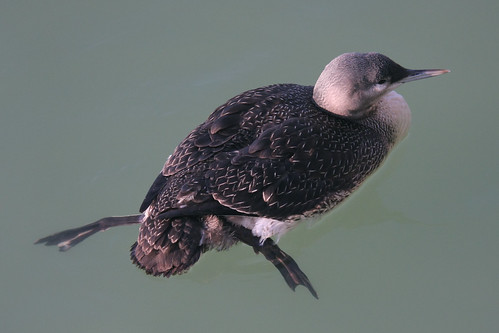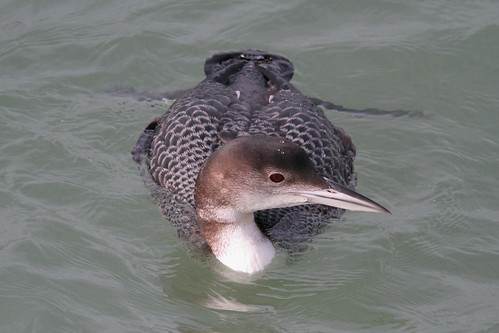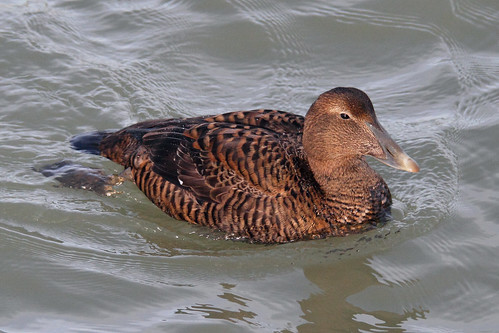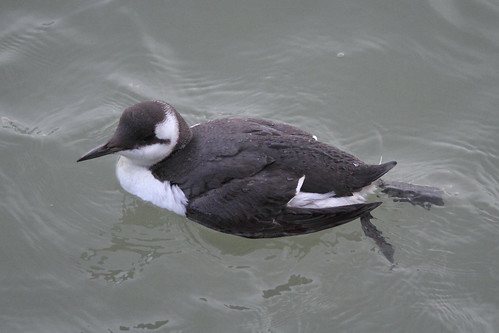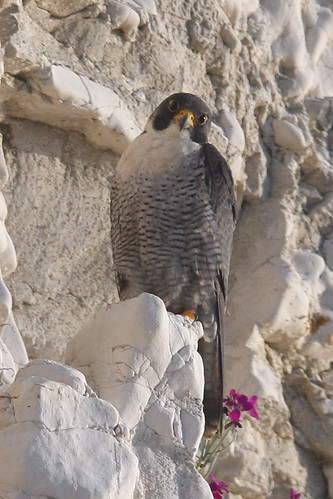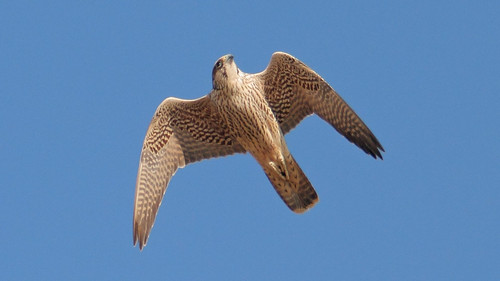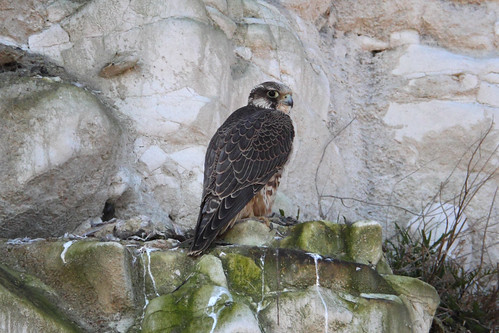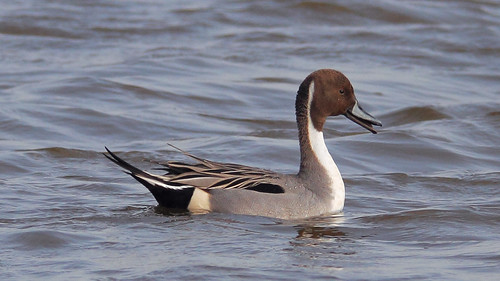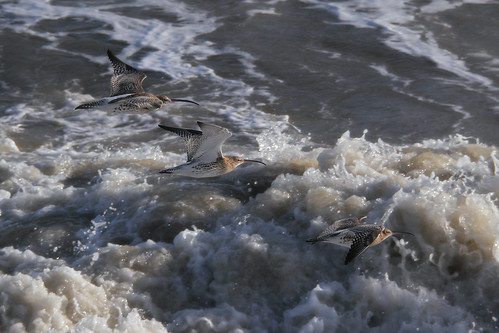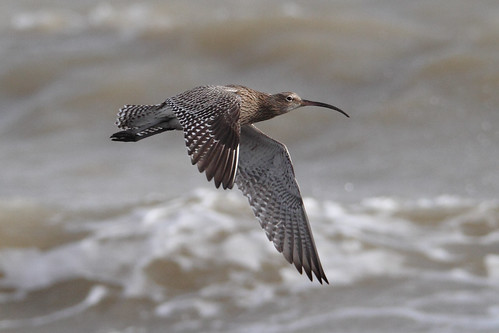Given that one of the attractions of going out with the camera is to escape from the hustle and bustle of everyday life, a busy harbour wouldn't normally be my first choice of destination. However, a visit to Ramsgate during the winter months may occasionally provide close-up views of certain sea-bird species which, while not being particularly rare, are more usually seen as distant specks flying above the waves.
This Red-throated Diver, photographed in November 2014, visited Ramsgate at a time when the harbour was getting a bit of a reputation for being a Diver graveyard. It wasn't feeding and the only time I saw it do anything other than float listlessly was when it was being harassed by a seal.
The R-TD eventually disappeared (almost certainly perished), but this Great Northern Diver, which arrived at Ramsgate the following winter, was in a much healthier condition. During its long residence it demonstrated that the harbour is home to a surprising variety of fish and crabs (at least, it was until the Diver ate them).
This female Eider (a sturdy sea-duck usually seen bobbing up and down a long way offshore) visited the harbour in January 2016. It paddled in, spent about half an hour looking around, diving, and flapping its wings, and then it paddled out again. Fortunately I happened to be in the right place at the right time (for once).
Although you can't see it from this angle, this Shag, photographed in November 2016, is sporting a blue colour ring (letters AUR). As reported by Scott Haughie, it was ringed on Staple Island up in the Farnes in June and made its way south to Ramsgate (other sightings from the scheme have been in Holland).
The Collins Guide says of auks: "Most commonly seen at coasts during and after gales", and so it proved with this little Guillemot, which took shelter in the harbour after Storm Angus had swept through the Channel.
Sea-going species aren't the only birds that make Ramsgate their home during winter. If you're lucky you may spot one of the local kingfishers, as documented by Keith Ross.
See also:
More of my photos from Ramsgate Harbour (Flickr)
Keith Ross's Video Channel (YouTube)
Saturday 10 December 2016
Birds of Ramsgate Harbour
Labels:
40D,
7D,
birds,
blogpost,
canon,
DSLR,
east kent,
eider,
great northern diver,
guillemot,
harbour,
kilner,
ramsgate,
red-throated diver,
shag,
Tele Vue,
TV60
Friday 17 June 2016
Birds of East Kent: Peregrine Falcon
Latest in an occasional series of posts discussing the different birds that can be found in East Kent.
The peregrine makes its presence felt long before you see it: a dead pigeon lies on its back on a windswept beach, its wings spread and its breastbone stripped of meat; a golfer notices your camera and calls out to tell you that you "just missed a peregrine"; fulmars cackle their disapproval as a crossbow-shaped shadow glides over their nests and across the cliff-face. You walk and you walk until finally you see a hunched, powerful-looking bird poised on an outcrop of flint. On the beach below a man is walking his dog, blissfully unaware of the apex predator right above his head, but when you peer through the lens you see that the peregrine is looking at you, not the dog or its owner. A peregrine sees everything and misses nothing. It spotted you the moment you stepped into its field of view, and now that it knows you're looking at it, the peregrine alone will decide how close you will be allowed to get.
Thanks to works like J.A. Baker's The Peregrine, the eponymous falcon enjoys a near-mythical status unmatched perhaps by any other British bird. Baker's account (I can't really call it a memoir since the author effectively excises himself from the narrative) condenses a decade's worth of observations into a single year, a structural choice which also has the effect of condensing his patient study of the peregrine into a singularly obsessive quest. Reading it, you're left in little doubt that Baker - short-sighted and afflicted with a rare and rather unpleasant form of arthritis (I speak from experience on the latter) - wishes he were a peregrine himself:
Like dark chocolate, Baker's dense, synaesthetic prose is probably best savoured in small chunks. And yet, for all the linguistic fireworks on display, the narrative is tinged with a wistful, elegiac tone. Baker had good reason to be pessimistic; at the time he wrote his book the peregrine was in serious decline - its numbers ravaged by persecution and pesticides.
But for once, the story has a happy postscript (albeit one that Baker himself didn't live to see). Peregrine Falcons have enjoyed a spectacular resurgence and you can now see them right across the country, repopulating urban environments as well as their more traditional hunting grounds. If you live near a cathedral or a high chalk cliff, there's a good chance you also live near a peregrine. And when you see one for yourself you'll understand why these majestic birds inspire such reverential prose.
See also:
More of my Peregrine photos on Flickr
Keith Ross's YouTube channel (includes a series of short films on the Ramsgate Peregrines)
Peregrine Falcon (RSPB)
Peregrine Falcon (Birdforum)
Peregrine Falcon (Birdguides)
The peregrine makes its presence felt long before you see it: a dead pigeon lies on its back on a windswept beach, its wings spread and its breastbone stripped of meat; a golfer notices your camera and calls out to tell you that you "just missed a peregrine"; fulmars cackle their disapproval as a crossbow-shaped shadow glides over their nests and across the cliff-face. You walk and you walk until finally you see a hunched, powerful-looking bird poised on an outcrop of flint. On the beach below a man is walking his dog, blissfully unaware of the apex predator right above his head, but when you peer through the lens you see that the peregrine is looking at you, not the dog or its owner. A peregrine sees everything and misses nothing. It spotted you the moment you stepped into its field of view, and now that it knows you're looking at it, the peregrine alone will decide how close you will be allowed to get.
Thanks to works like J.A. Baker's The Peregrine, the eponymous falcon enjoys a near-mythical status unmatched perhaps by any other British bird. Baker's account (I can't really call it a memoir since the author effectively excises himself from the narrative) condenses a decade's worth of observations into a single year, a structural choice which also has the effect of condensing his patient study of the peregrine into a singularly obsessive quest. Reading it, you're left in little doubt that Baker - short-sighted and afflicted with a rare and rather unpleasant form of arthritis (I speak from experience on the latter) - wishes he were a peregrine himself:
Free! You cannot know what freedom means till you have seen a peregrine loosed into the warm spring sky to roam at will through all the far provinces of light. Along the escarpments of the river air he rose with martial motion. Like a dolphin in green seas, like an otter in the startled water, he poured through deep lagoons of sky up to the high white reefs of cirrus.
Like dark chocolate, Baker's dense, synaesthetic prose is probably best savoured in small chunks. And yet, for all the linguistic fireworks on display, the narrative is tinged with a wistful, elegiac tone. Baker had good reason to be pessimistic; at the time he wrote his book the peregrine was in serious decline - its numbers ravaged by persecution and pesticides.
But for once, the story has a happy postscript (albeit one that Baker himself didn't live to see). Peregrine Falcons have enjoyed a spectacular resurgence and you can now see them right across the country, repopulating urban environments as well as their more traditional hunting grounds. If you live near a cathedral or a high chalk cliff, there's a good chance you also live near a peregrine. And when you see one for yourself you'll understand why these majestic birds inspire such reverential prose.
See also:
More of my Peregrine photos on Flickr
Keith Ross's YouTube channel (includes a series of short films on the Ramsgate Peregrines)
Peregrine Falcon (RSPB)
Peregrine Falcon (Birdforum)
Peregrine Falcon (Birdguides)
Friday 8 April 2016
Oare Marshes
Alternative Title: A long overdue write-up of a long overdue trip
The Oare Marshes KWT reserve is a bit further afield than my usual haunts, but I fancied a change of scene and so I took advantage of a warm March day to pay my first visit. The walk from Faversham station is actually quite pleasant if you don't mind a bit of a trek, but it seems a lot of the visiting photographers/birders park along the road that runs through the middle of the reserve, get the required photos/ticks, and then drive off to the next location - sometimes without even leaving their cars! Such is the accelerated and competitive nature of modern life, but you'll forgive me if I prefer a more sedate approach.
The reserve is quite contained; you can walk all the way around it a lot quicker than, say, the extended Grove Ferry/Stodmarsh circuit. I must have walked round it one-and-a-half times while I was there - perhaps more if you factor in the distance I covered trailing after the mixed flock of Goldfinches and Lesser Redpolls:
For those who wish to give their feet a rest, there are three hides on the reserve. On the day I visited they were all in pretty good condition. They also happened to be completely empty, which is not entirely surprising given that a) there were no birds anywhere near them, and b) they were facing directly into the wind - which made for an eye-watering experience. Fortunately most of the highlight species could be seen quite easily from the viewing points along the road, including this uncharacteristically obliging Water Rail:
I don't generally keep lists, but on this occasion I jotted down all the birds I'd seen and heard (written that same evening, from memory). I counted forty-one different species, which were - for those who are interested in such things - as follows: Avocet, Bearded Tit, Blackbird, Black-headed Gull, Black-tailed Godwit, Blue Tit, Canada Goose, Carrion Crow, Cetti's Warbler, Coot, Curlew, Dunnock, Goldfinch, Green Woodpecker, Grey Heron, Greylag Goose, Herring Gull, Lesser Redpoll, Little Egret, Little Grebe, Magpie, Mallard, Marsh Harrier, Meadow Pipit, Moorhen, Mute Swan, Oystercatcher, Peregrine Falcon, Pintail, Redshank, Reed Bunting, Robin, Shelduck, Shoveler, Skylark, Snipe, Starling, Teal, Tufted Duck, Water Rail, and Wood Pigeon.
Not bad for a first visit, though having read subsequent reports it's possible that I may have walked past a Little Owl without spotting it. Sounds like a good excuse for a return trip...
See also:
More of my photos from Oare Marshes
Oare Marshes (Kent Wildlife Trust)
Oare Marshes Latest Sightings (KOS)
Labels:
#springwatch,
7D,
birds,
blogpost,
canon,
Faversham,
kent,
kilner,
KWT,
Oare,
Oare Marshes,
photography,
Tele Vue,
telescope,
wildlife
Tuesday 12 January 2016
Birds of East Kent: Curlew
Latest in an occasional series of posts discussing the different birds that can be found in East Kent and how easy (or not) it is to get a decent picture of them.
What's your favourite bird song? Probably the first birds that spring to mind are Robins or Skylarks (or even a Nightingale if you've been lucky enough to hear one), but for me there are few sounds more evocative in English nature than the fluting call of a Curlew echoing over a mudflat or across a fog-shrouded beach. It has something of a plaintive quality to it, which is perhaps appropriate as the Curlew is now sadly on the UK's Red List due to severe declines in its breeding population.
In the winter at least there are still plenty to see around the coast as the numbers are bolstered by European visitors. In my little corner of the country, they're a common sight at low tide, probing for food with their unmistakable long bills on the seaweed-covered rocks. At high tide you'll often find them sheltering in one of the communal roosts between Foreness and Kingsgate Bay, protected by the cliffs on one side and the sea on the other. You may also spot them on the fields near the North Foreland lighthouse, or flying in loose flocks close to the shore:
With regards to photography they don't tolerate people as much as the other local seaside birds like Turnstones and Purple Sandpipers, but as they're Britain's largest wader you don't need to be that close to get a good shot. Best advice is to approach very slowly, keep low if possible, and always be ready for that dramatic take-off:
And of course, that amazing song.
See also:
More of my Curlew photos on Flickr
Curlew (RSPB)
Curlew (Birdforum)
Curlew (Birdguides)
Curlews in April
Hang their harps over the misty valleys
A wobbling water-call
A wet-footed god of the horizons
Ted Hughes, "Curlews", Remains of Elmet (1979)
What's your favourite bird song? Probably the first birds that spring to mind are Robins or Skylarks (or even a Nightingale if you've been lucky enough to hear one), but for me there are few sounds more evocative in English nature than the fluting call of a Curlew echoing over a mudflat or across a fog-shrouded beach. It has something of a plaintive quality to it, which is perhaps appropriate as the Curlew is now sadly on the UK's Red List due to severe declines in its breeding population.
In the winter at least there are still plenty to see around the coast as the numbers are bolstered by European visitors. In my little corner of the country, they're a common sight at low tide, probing for food with their unmistakable long bills on the seaweed-covered rocks. At high tide you'll often find them sheltering in one of the communal roosts between Foreness and Kingsgate Bay, protected by the cliffs on one side and the sea on the other. You may also spot them on the fields near the North Foreland lighthouse, or flying in loose flocks close to the shore:
With regards to photography they don't tolerate people as much as the other local seaside birds like Turnstones and Purple Sandpipers, but as they're Britain's largest wader you don't need to be that close to get a good shot. Best advice is to approach very slowly, keep low if possible, and always be ready for that dramatic take-off:
And of course, that amazing song.
See also:
More of my Curlew photos on Flickr
Curlew (RSPB)
Curlew (Birdforum)
Curlew (Birdguides)
Subscribe to:
Posts (Atom)

